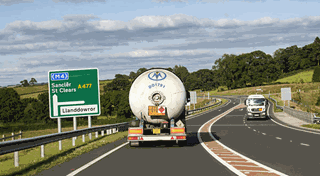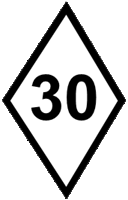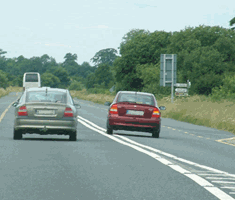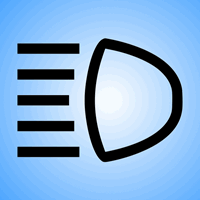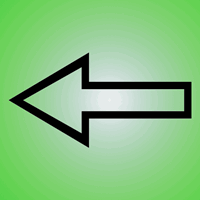The Attitude Theory Test consists of 39 questions.
You need 34 out of 39 (86%) to pass. There is no time limit for this test.
Click here to read our Attitude Theory Test revision notes.
There are no tests related to this category :
There are no tests related to this category :
Quick view of test questions. Click question box to reveal correct answer.
Correct Answer: B
Explanation: Pelican crossings are pedestrian-operated signalised crossings. The signals are changed using push-button controls. There is no red-and-amber stage preceding green at pelican crossings. Instead, there is a flashing amber light. This means you must yield to pedestrians who are already crossing the street. However, if the crossing is clear, you can proceed.
Explanation: Pelican crossings are pedestrian-operated signalised crossings. The signals are changed using push-button controls. There is no red-and-amber stage preceding green at pelican crossings. Instead, there is a flashing amber light. This means you must yield to pedestrians who are already crossing the street. However, if the crossing is clear, you can proceed.
2. Why shouldn't you gesture people to cross, by waving or otherwise, at pedestrian crossings?
Mark one answer
AB
C
D
Correct Answer: A
Explanation: Reduce your speed and get ready to stop if you see people waiting at a pedestrian crossing. Don't prompt them to cross the road by gesturing to them. This could be potentially dangerous as other drivers may not be able to stop in time if they fail to see the pedestrians.
Explanation: Reduce your speed and get ready to stop if you see people waiting at a pedestrian crossing. Don't prompt them to cross the road by gesturing to them. This could be potentially dangerous as other drivers may not be able to stop in time if they fail to see the pedestrians.
Correct Answer: A
Explanation: When a driver or rider follows the vehicle in front of them too closely, it is referred to as 'tailgating.' It's unsafe because it limits their view of the road ahead. It leaves no room for error if the vehicle in front of them unexpectedly slows down or stops. Tailgating is often the primary cause of rear-end accidents and pile-ups.
Explanation: When a driver or rider follows the vehicle in front of them too closely, it is referred to as 'tailgating.' It's unsafe because it limits their view of the road ahead. It leaves no room for error if the vehicle in front of them unexpectedly slows down or stops. Tailgating is often the primary cause of rear-end accidents and pile-ups.
Correct Answer: C
Explanation: Maintaining your distance will give you a better view of the road ahead. This will allow you to see any potential hazards and give you more time to respond.
Explanation: Maintaining your distance will give you a better view of the road ahead. This will allow you to see any potential hazards and give you more time to respond.
5. You're driving behind a vehicle on a wet road. What time gap should you leave between your vehicle and the one you're following?
Mark one answer
AB
C
D
Correct Answer: A
Explanation: The grip of your tyres on the road will be reduced by water. In rainy weather, the two-second safe separation gap should be increased to four seconds.
Explanation: The grip of your tyres on the road will be reduced by water. In rainy weather, the two-second safe separation gap should be increased to four seconds.
6. An LGV (Large Goods Vehicle) carrying a heavy load intends to overtake you, but is taking a long time to do so. How should you react?
Mark one answer
AB
C
D
Correct Answer: C
Explanation: A long lorry carrying a heavy load will take longer to pass you than a car, particularly if the road is uphill. Enable the lorry to pass by slowing down.
Explanation: A long lorry carrying a heavy load will take longer to pass you than a car, particularly if the road is uphill. Enable the lorry to pass by slowing down.
Correct Answer: A
Explanation: Blue flashing lights are used by emergency vehicles to provide additional warning of a hazard. If you see or hear one approaching, move out of its way, providing it's safe and legal to do so.
Explanation: Blue flashing lights are used by emergency vehicles to provide additional warning of a hazard. If you see or hear one approaching, move out of its way, providing it's safe and legal to do so.
A
B
C
D
B
C
D
Correct Answer: C
Explanation: Pull over to the side of the road so that the ambulance can safely pass. Make sure there aren't any bollards or other hazards in the road that would hinder the ambulance’s progress.
Explanation: Pull over to the side of the road so that the ambulance can safely pass. Make sure there aren't any bollards or other hazards in the road that would hinder the ambulance’s progress.
Correct Answer: A
Explanation: A vehicle with a green flashing beacon indicates that the driver or passenger is a doctor on call. If it's safe to do so, give way to the vehicle. Keep in mind that the vehicle may be travelling at speed or may make a sudden stop.
Explanation: A vehicle with a green flashing beacon indicates that the driver or passenger is a doctor on call. If it's safe to do so, give way to the vehicle. Keep in mind that the vehicle may be travelling at speed or may make a sudden stop.
Correct Answer: D
Explanation: Diamond-shaped traffic signs are specific to tram drivers. However, drivers of other vehicles should know what they mean so they're aware of what the tram driver may do and what their priorities are.
Explanation: Diamond-shaped traffic signs are specific to tram drivers. However, drivers of other vehicles should know what they mean so they're aware of what the tram driver may do and what their priorities are.
Correct Answer: C
Explanation: Tram rails are more slippery than tarmac, and could potentially cause cyclists to lose their balance or fall. Additionally, narrow bicycle wheels can get stuck in tram rails, causing them to wobble, stop, or lose their balance.
Explanation: Tram rails are more slippery than tarmac, and could potentially cause cyclists to lose their balance or fall. Additionally, narrow bicycle wheels can get stuck in tram rails, causing them to wobble, stop, or lose their balance.
Correct Answer: A
Explanation: Unless a moving vehicle presents a danger, your horn should not be used between 11:30pm and 7am in built up areas or while stationary. The purpose of the horn is to let other road users know you're there.
Explanation: Unless a moving vehicle presents a danger, your horn should not be used between 11:30pm and 7am in built up areas or while stationary. The purpose of the horn is to let other road users know you're there.
13. You want to turn right in a one-way street that has two lanes. Which lane should you use?
Mark one answer
AB
C
D
Correct Answer: C
Explanation: When turning right on a one-way street, you should position yourself in the right-hand lane. This way, anyone not turning can pass on your left. Ensure you indicate in good time, and switch lanes early to let everyone know your intentions.
Explanation: When turning right on a one-way street, you should position yourself in the right-hand lane. This way, anyone not turning can pass on your left. Ensure you indicate in good time, and switch lanes early to let everyone know your intentions.
14. You intend to turn right further down the road. Why should you move into position well in advance to perform this manoeuvre?
Mark one answer
AB
C
D
Correct Answer: A
Explanation: You should indicate and move into position for the turn early. The correct position is nearer the centre of the road, allowing vehicles not turning to pass on your left. Giving nearby drivers early warning of your intentions helps prevent hazards.
Explanation: You should indicate and move into position for the turn early. The correct position is nearer the centre of the road, allowing vehicles not turning to pass on your left. Giving nearby drivers early warning of your intentions helps prevent hazards.
Correct Answer: C
Explanation: Toucan crossings allow both cyclists and pedestrians to cross simultaneously. Cyclists may approach the crossing at high speeds, so be extra wary of this.
Explanation: Toucan crossings allow both cyclists and pedestrians to cross simultaneously. Cyclists may approach the crossing at high speeds, so be extra wary of this.
16. A vehicle behind you accelerates and flashes its lights at you. You are already driving at the legal speed limit. What should you do?
Mark one answer
AB
C
D
Correct Answer: B
Explanation: Blocking another vehicle's progress to enforce a speed limit will only frustrate the driver behind, potentially making the situation more dangerous. You should allow the vehicle to pass when it's safe to do so.
Explanation: Blocking another vehicle's progress to enforce a speed limit will only frustrate the driver behind, potentially making the situation more dangerous. You should allow the vehicle to pass when it's safe to do so.
17. Which of the following is a valid reason for flashing your headlights at other drivers?
Mark one answer
AB
C
D
Correct Answer: B
Explanation: Your headlights should only be flashed to warn other drivers that you're there. They should not be used in frustration, to give others priority, or to greet people. This could cause a misunderstanding, increasing risk of a collision.
Explanation: Your headlights should only be flashed to warn other drivers that you're there. They should not be used in frustration, to give others priority, or to greet people. This could cause a misunderstanding, increasing risk of a collision.
Correct Answer: C
Explanation: You should be cautious at unmarked junctions, especially where obstructions - such as hedges, parked cars, and buildings - block your view. In summer months, foliage may have grown to obstruct your view further, so take extra care.
Explanation: You should be cautious at unmarked junctions, especially where obstructions - such as hedges, parked cars, and buildings - block your view. In summer months, foliage may have grown to obstruct your view further, so take extra care.
Correct Answer: B
Explanation: The 'two-second rule' can be used to judge the distance between you and the vehicle in front in good conditions. Look ahead for a fixed object - road markings or signs, for example - and begin saying this phrase when the vehicle ahead passes it: 'Only a fool breaks the two-second rule.' This phrase takes two seconds to say, so if you're unable to finish it before passing the object, you're too close.
Explanation: The 'two-second rule' can be used to judge the distance between you and the vehicle in front in good conditions. Look ahead for a fixed object - road markings or signs, for example - and begin saying this phrase when the vehicle ahead passes it: 'Only a fool breaks the two-second rule.' This phrase takes two seconds to say, so if you're unable to finish it before passing the object, you're too close.
Correct Answer: C
Explanation: Infra-red sensors at Puffin crossings detect when pedestrians are still crossing, and keep the red light showing until they've crossed. There is no flashing amber phase at puffin crossings, setting them apart from pelican crossings.
Explanation: Infra-red sensors at Puffin crossings detect when pedestrians are still crossing, and keep the red light showing until they've crossed. There is no flashing amber phase at puffin crossings, setting them apart from pelican crossings.
21. You are in slow-moving traffic. What action should you take if the driver behind you is too close?
Mark one answer
AB
C
D
Correct Answer: D
Explanation: Drivers following too closely increases the risk of collision, as there's less time for them to brake if you suddenly need to stop. The best thing to do is slow down, increasing the gap in front of you. Doing this lessens the odds that you'll have to stop suddenly, giving you more space to brake in case of a hazard. This is an example of defensive driving.
Explanation: Drivers following too closely increases the risk of collision, as there's less time for them to brake if you suddenly need to stop. The best thing to do is slow down, increasing the gap in front of you. Doing this lessens the odds that you'll have to stop suddenly, giving you more space to brake in case of a hazard. This is an example of defensive driving.
22. When driving at night towards oncoming traffic, which lights should you use on a national speed limit road?
Mark one answer
AB
C
D
Correct Answer: A
Explanation: Full-beam headlights can dazzle other drivers. Only use them when you're sure other road users won't be dazzled.
Explanation: Full-beam headlights can dazzle other drivers. Only use them when you're sure other road users won't be dazzled.
23. What should you do if an LGV (large goods vehicle) indicates left but steers right?
Mark one answer
AB
C
D
Correct Answer: C
Explanation: Large, long vehicles may move to the right side of the road in order to make a left turn. This is because they need extra room while turning. Don't attempt to pass them on the left. Stay back and give them plenty of space.
Explanation: Large, long vehicles may move to the right side of the road in order to make a left turn. This is because they need extra room while turning. Don't attempt to pass them on the left. Stay back and give them plenty of space.
Correct Answer: B
Explanation: It is inevitable that other drivers will make bad decisions and mistakes. Keep calm and don't retaliate or driver aggressively. The safety of you, your passengers, and other road users should always come fire.
Explanation: It is inevitable that other drivers will make bad decisions and mistakes. Keep calm and don't retaliate or driver aggressively. The safety of you, your passengers, and other road users should always come fire.
25. What can you do to avoid dazzling drivers behind you at night, while waiting in traffic?
Mark one answer
AB
C
D
Correct Answer: A
Explanation: When possible, you should apply your handbrake while queuing in traffic. Keeping your footbrake depressed can cause your brake lights to dazzle drivers behind.
Explanation: When possible, you should apply your handbrake while queuing in traffic. Keeping your footbrake depressed can cause your brake lights to dazzle drivers behind.
26. You're being followed closely by a driver who is trying to overtake you. How should you react?
Mark one answer
AB
C
D
Correct Answer: B
Explanation: Responding incorrectly to impatient drivers can cause hazards and collisions. You should maintain your course and allow the driver behind to overtake. Slow down if necessary.
Explanation: Responding incorrectly to impatient drivers can cause hazards and collisions. You should maintain your course and allow the driver behind to overtake. Slow down if necessary.
Correct Answer: A
Explanation: The times of operation of a bus lane and the types of vehicles allowed to use it are shown on bus-lane signs. If a sign shows no hours of operation, it is a 24-hour bus lane.
Explanation: The times of operation of a bus lane and the types of vehicles allowed to use it are shown on bus-lane signs. If a sign shows no hours of operation, it is a 24-hour bus lane.
Correct Answer: D
Explanation: Animals are unpredictable. If startled, they could run into your path or the path of another vehicle. You should stop and turn off your engine if someone in charge of animals asks you to do so.
Explanation: Animals are unpredictable. If startled, they could run into your path or the path of another vehicle. You should stop and turn off your engine if someone in charge of animals asks you to do so.
Correct Answer: C
Explanation: Passing too closely, too loudly, or too quickly can cause horses to startle or panic. Give them plenty of room as you pass, keeping your speed and engine revs low. You may need to go onto the other side of the road to pass safely.
Explanation: Passing too closely, too loudly, or too quickly can cause horses to startle or panic. Give them plenty of room as you pass, keeping your speed and engine revs low. You may need to go onto the other side of the road to pass safely.
A
B
C
D
B
C
D
Correct Answer: C
Explanation: Always check for waiting pedestrians as you approach zebra crossings. If you see any, slow down and be prepared to stop. Children and the elderly may cross unpredictably or slowly, so be especially careful around them.
Explanation: Always check for waiting pedestrians as you approach zebra crossings. If you see any, slow down and be prepared to stop. Children and the elderly may cross unpredictably or slowly, so be especially careful around them.
Correct Answer: C
Explanation: Planning ahead and anticipating hazards makes you better prepared for the unexpected. Knowing what's around you helps you predict problems that might arise. Other drivers will inevitably make mistakes; keep calm and react in the safest way possible.
Explanation: Planning ahead and anticipating hazards makes you better prepared for the unexpected. Knowing what's around you helps you predict problems that might arise. Other drivers will inevitably make mistakes; keep calm and react in the safest way possible.
32. Pedestrians are crossing a puffin crossing ahead of you. When will the lights change from red?
Mark one answer
AB
C
D
Correct Answer: C
Explanation: Puffin crossings have infra-red sensors that detect when the crossing is clear. Only drive on when the green light shows, indicating it is safe.
Explanation: Puffin crossings have infra-red sensors that detect when the crossing is clear. Only drive on when the green light shows, indicating it is safe.
Correct Answer: A
Explanation: Ensure you are familiar with all of the visual aids and warning lights on your vehicle's dashboard. Take time to learn them before driving a new vehicle for the first time, ensuring you know how to respond when they light up.
Explanation: Ensure you are familiar with all of the visual aids and warning lights on your vehicle's dashboard. Take time to learn them before driving a new vehicle for the first time, ensuring you know how to respond when they light up.
34. You should leave a two-second gap between you and the vehicle in front under which conditions?
Mark one answer
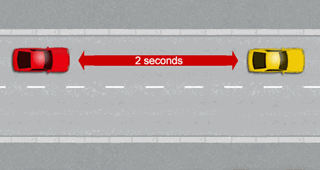
B
C
D
Correct Answer: A
Explanation: Use the 'two-second rule' in good, dry conditions, staying at least two seconds from any vehicle in front. This allows time and space for you to stop if the driver ahead stops suddenly
Explanation: Use the 'two-second rule' in good, dry conditions, staying at least two seconds from any vehicle in front. This allows time and space for you to stop if the driver ahead stops suddenly
A
B
C
D
B
C
D
Correct Answer: D
Explanation: The drivers of vehicles ahead could be dazzled if you drive behind them with your full-beam headlights on. Ensure your lights are dipped when following other vehicles at night, and leave an amount of space appropriate for the conditions
Explanation: The drivers of vehicles ahead could be dazzled if you drive behind them with your full-beam headlights on. Ensure your lights are dipped when following other vehicles at night, and leave an amount of space appropriate for the conditions
36. You're driving a slow vehicle on a narrow road. There is traffic behind you. What should you do?
Mark one answer
AB
C
D
Correct Answer: C
Explanation: Waving traffic past could be dangerous, as they won't have been able to look past you to spot hazards you could have missed. If vehicles begin to queue behind you, the best thing to do is find a safe place to pull over and let them past.
Explanation: Waving traffic past could be dangerous, as they won't have been able to look past you to spot hazards you could have missed. If vehicles begin to queue behind you, the best thing to do is find a safe place to pull over and let them past.
Correct Answer: A
Explanation: An improperly secured filler cap can cause fuel to spill, usually at junctions, roundabouts, and on bends. Spilled fuel makes the road surface slippery. This is especially true during long periods of dry weather, when there's been no rain to wash away previous spills.
Explanation: An improperly secured filler cap can cause fuel to spill, usually at junctions, roundabouts, and on bends. Spilled fuel makes the road surface slippery. This is especially true during long periods of dry weather, when there's been no rain to wash away previous spills.
Correct Answer: B
Explanation: Practising filling your fuel tank is a good thing to do while learning to drive. If your instructor does not offer to help you do this, ask them. Learn how to spot the filler cap on your car, how to pull up at the pump, and take care not to overfill your tank to avoid spilling any excess fuel onto the road.
Explanation: Practising filling your fuel tank is a good thing to do while learning to drive. If your instructor does not offer to help you do this, ask them. Learn how to spot the filler cap on your car, how to pull up at the pump, and take care not to overfill your tank to avoid spilling any excess fuel onto the road.
Correct Answer: A
Explanation: Questioning the actions of other road users is defensive driving, and can help you predict possible hazards and react accordingly. The opposite driving style is competitive driving. This increases the risk of collision for all other nearby road users.
Explanation: Questioning the actions of other road users is defensive driving, and can help you predict possible hazards and react accordingly. The opposite driving style is competitive driving. This increases the risk of collision for all other nearby road users.


